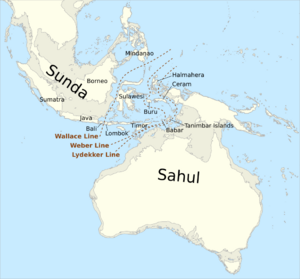Earth:Land bridge

In biogeography, a land bridge is an isthmus or wider land connection between otherwise separate areas, over which animals and plants are able to cross and colonize new lands. A land bridge can be created by marine regression, in which sea levels fall, exposing shallow, previously submerged sections of continental shelf; or when new land is created by plate tectonics; or occasionally when the sea floor rises due to post-glacial rebound after an ice age.
Prominent examples
Former land bridges
- The Bassian Plain, which linked Australia and Tasmania
- The Bering Land Bridge (aka Beringia), which intermittently connected Alaska (Northern America) with Siberia (North Asia) as sea levels rose and fell under the effect of ice ages
- Land bridges of Japan, several land bridges which connected Japan to Russia and Korea at various times in history.
- De Geer Land Bridge, a route that connected Fennoscandia to northern Greenland
- Doggerland, a former landmass in the southern North Sea which connected the island of Great Britain to continental Europe during the last ice age
- The Thule Land Bridge, a since disappeared land bridge between the British Isles and Greenland
- Torres Strait land bridge, Sahul, between modern-day West Papua and Cape York
- Sundaland, a 1,800,000 km2 area which connected the islands of Southeast Asia at various points during the last 2.6 million years
Current land bridges
- Adam's Bridge (also known as Rama Setu), connecting India and Sri Lanka
- The Isthmus of Panama, whose appearance three million years ago allowed the Great American Biotic Interchange between North America and South America[1]
- The Sinai Peninsula, linking Africa and Eurasia
Land bridge theory

In the 19th century, scientists including Joseph Dalton Hooker noted puzzling geological, botanical, and zoological similarities between widely separated areas. To solve these problems, they proposed land bridges between appropriate land masses.[2][3] In geology, the concept was first proposed by Jules Marcou in Lettres sur les roches du Jura et leur distribution géographique dans les deux hémisphères ("Letters on the rocks of the Jura [Mountains] and their geographic distribution in the two hemispheres"), 1857–1860.[3]
The hypothetical land bridges included:[3]
- Archatlantis from the West Indies to North Africa
- Archhelenis from Brazil to South Africa
- Archiboreis in the North Atlantic
- Archigalenis from Central America through Hawaii to Northeast Asia
- Archinotis from South America to Antarctica
- Lemuria in the Indian Ocean
The theory of continental drift provided an alternate explanation that did not require land bridges.[4] However the continental drift theory was not widely accepted until the development of plate tectonics in the early 1960s, which more completely explained the motion of continents over geological time.[5][6]
See also
References
- ↑ 1.0 1.1 Webb, S. David (23 August 2006). "The Great American Biotic Interchange: Patterns and Processes". Annals of the Missouri Botanical Garden 93 (2): 245–257. doi:10.3417/0026-6493(2006)93[245:TGABIP2.0.CO;2].
- ↑ 2.0 2.1 Winkworth, Richard C. (2010). "Darwin and dispersal". Biology International 47: 139–144. https://www.researchgate.net/publication/258120865.
- ↑ 3.0 3.1 3.2 Corliss, William R. (June 1975). Mysteries Beneath the Sea. Apollo Editions. ISBN 978-0815203735. Chapter 5: "Up-and-Down Landbridges".
- ↑ Holmes, Arthur (18 April 1953). "Land Bridges or Continental Drift?". Nature: 669-671. https://www.nature.com/articles/171669a0.pdf.
- ↑ Le Pichon, Xavier (15 June 1968). "Sea-floor spreading and continental drift". Journal of Geophysical Research 73 (12): 3661–97. doi:10.1029/JB073i012p03661. Bibcode: 1968JGR....73.3661L.
- ↑ Mc Kenzie, D.; Parker, R.L. (1967). "The North Pacific: an example of tectonics on a sphere". Nature 216 (5122): 1276–1280. doi:10.1038/2161276a0. Bibcode: 1967Natur.216.1276M.
Further reading
 Ernest Ingersoll (1920). "Land-Bridges Across the Oceans". Encyclopedia Americana.
Ernest Ingersoll (1920). "Land-Bridges Across the Oceans". Encyclopedia Americana.
External links
 |


